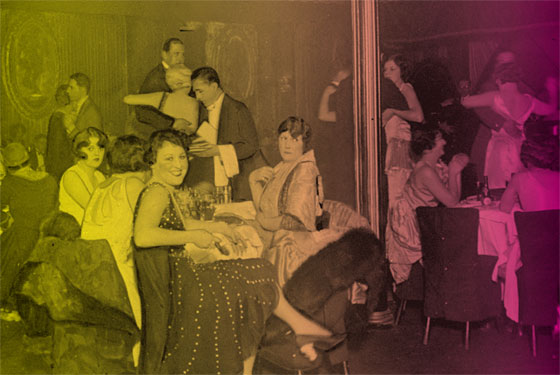
It was 80 years ago this week that federal agents stormed the Hollywood, a glamorous nightclub on Broadway and 48th Street. To the 600 patrons present that evening, the Hip Flask Raid, as it became known, was one of the greatest shocks to hit New York since the reign of Prohibition had begun ten years earlier—not because raids were uncommon but because this was the first time the Feds arrested city drinkers (eleven of them). Until then, proprietors and employees would get hauled to court (and peremptorily fined and released), and customers would promptly move on to the next watering hole.
But what appeared to be an instance of Dry America flexing its muscles was in fact one of its dying gasps. Soon the anti-Prohibition anger caused by overreaching enforcement efforts was eclipsed by even more powerful pro-repeal arguments: The spiraling Depression had rendered the federal government desperate for tax revenue, and Americans were desperate for jobs. The return of legal booze upon repeal in late 1933 was a step toward satisfying both desires. Though Prohibition ended, a curious legacy survives, and the anniversary of the Hip Flask Raid provides an opportunity to reflect upon how the Dry Era changed the way New Yorkers drank—and how it all but created urban nightlife as we know it today:
You go to bars to date and flirt.
Before the Eighteenth Amendment—barring the sale, manufacture, and transportation of intoxicating beverages—went into effect in 1920, drinking was mostly a sexually segregated activity. Well-off women may have imbibed with their men in hotel restaurants, but the saloon was a male-only institution. The drinking spots that bloomed during Prohibition saw no reason to discriminate. Established outside the law, they inevitably turned away from established convention. “A pretty girl in a speakeasy,” said songwriter Alec Wilder, “was the most beautiful girl in the world,” and the presence of thousands upon thousands of them made the speakeasies more popular than mere alcohol could. Of course, the sudden need for separate restrooms in the former saloons provoked the rushed installation of tiny bathrooms tucked into unused corners. These novel facilities were identified by a Prohibition neologism that stuck around: the powder room.
You go out to be entertained.
Coeducational drinking in turn called for coeducational entertainment, and an outlaw music—jazz—provided the dance beat in hundreds of outlaw establishments; thus, the modern nightclub. White revelers began to go to Harlem in ermine and pearls, and clubs began offering table service for couples out on the town together.
But you also party at home.
Returning to New York in 1923 after two years in Paris, critic Malcolm Cowley marveled at the invention of “the ‘party,’ conceived as a gathering of men and women to drink gin cocktails, flirt, dance to the phonograph or radio, and gossip about their absent friends.” Vanity Fair advised its readers “how to bait your social hook during these trying days of drought.” One winking suggestion: Tell guests to “bring your corkscrew.”
You order brand-name liquor.
Every time you request a Maker’s Mark on the rocks, you’re acknowledging an atavistic fear of the tens of millions of gallons of legal “industrial alcohol,” ostensibly meant for use in the manufacture of everything from aftershave to explosives, that Prohibition-era gangsters would color with creosote or other squirrelly substances and pour into the city’s nightlife. In the old saloons, you would have asked for a whiskey; in the better speakeasies, fear of the unknown and the uncertified changed the drinker’s call for a neat Scotch into a request for a Dewar’s.
The best bars are secret.
Well, this one doesn’t really hold. Having spent the last several years researching the history of Prohibition, I’ve been amused to watch New York’s nightlife scene undergo an indulgent round of Prohibition-chic: drinking places with no signage and no listed phone number, private rooms behind restaurant kitchens. But these “secret” drinking spots are a fantasist’s version of what Prohibition drinking was really like in New York. Yes, in the early days, peepholes and secret entrances weren’t uncommon. But soon the Dry Regime was rendered impotent by the apathy of New York politicians, the corruption of New York cops—one official estimate had them pocketing $60 million in protection payoffs annually—and sheer human impulse. According to Police Commissioner Grover Whalen, by 1930 New York was home to 32,000 speakeasies, and most of them served booze flagrantly.
Thirty-six years later, after several decades of legal success with his Seagram’s brands had whitewashed his reputation, the Canadian bootlegger Sam Bronfman explained it best: “You people were thirsty.”